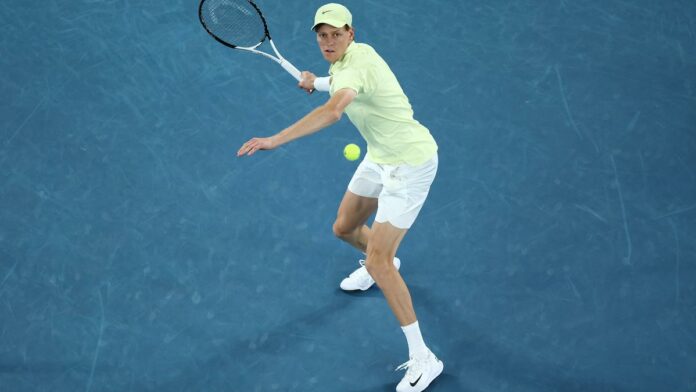On February 15, in the immediate aftermath of the announcement of a case resolution agreement between World Anti-Doping Agency (WADA) and World No. 1 Jannik Sinner that resulted in the latter being banned for three months for two positive tests in March 2024 for the substance clostebol, three-time Major champion Stan Wawrinka put out a blunt statement on social media platform X: “I don’t believe in a clean sport anymore…”
Spaniard Feliciano Lopez, who peaked in singles at No. 12 and is currently the tournament director of the Mutua Madrid Masters 1000, chimed in. “I do Stan,” he said. “It’s very clear he hasn’t done anything to enhance his performance, that’s proven. He’s taking full responsibility for others’ mistake and [serving] three months suspension consequently. Longer suspension would’ve made the sport cleaner? I don’t think so.”
Dividing opinion
The split between Wawrinka and Lopez was emblematic of the chasm that has developed in the world of tennis over the matter. At the heart of the debate is the perceived opaqueness and favouritism that many players, 24-time Slam champion Novak Djokovic included, feel the issue reeks of.
What has annoyed the rank and file of the sport is the fact that Sinner’s positive test was not made public until his exoneration in August 2024 by an independent tribunal; that he was allowed to play through this period except for a sum total of six days when he was provisionally suspended, and that WADA, after appealing the verdict and asking for a one-to-two-year ban, settled for just three months.
It has also not helped that women’s World No. 2 and five-time Major winner Iga Swiatek was handed a one-month expulsion in November 2024 for a doping offence. Tennis couldn’t remember the last time two of its biggest stars got entangled in drug-related matters at nearly the same time.
Juxtaposed against former World No. 1 Simona Halep’s travails — provisionally out in Oct. 2022, banned for four years in Sept. 2023, the Court of Arbitration for Sport (CAS) reducing it to nine months in March 2024 and her retirement earlier this year — it seemed Sinner and Swiatek had walked away lightly.
The timing of their sanctions has been deemed “convenient”, for Sinner will not miss a single Major. Swiatek missed three events — two WTA 1000s and one 500 — while being provisionally ineligible, but none as big as the WTA Finals and the Billie Jean King Cup Finals that followed.
But is such a strong reaction from the tennis community really justified? For a start, the International Tennis Integrity Agency (ITIA) protocol that governs the sport’s anti-doping code is pretty clear and there is no disputing that it was followed in all the aforementioned cases. If a prohibited substance is found, a provisional suspension immediately kicks in. But the player can appeal to an independent tribunal (appointed by Sport Resolutions, an independent organisation) within 10 days.
If successful, the player’s privacy will be protected and he or she will be allowed to compete while a full-fledged investigation runs parallelly. If the appeal is dismissed, the issue is made public and the player cannot compete until the end of the investigation.
Convincing argument
Sinner was able to convince the tribunal — not once but twice — that he bore “no fault or negligence” and that it was a case of transdermal contamination. Backed by testimonies and a paper trail, Sinner argued that the substance had entered his body while his physio Giacomo Naldi was giving him a massage and that the latter had used an Italian-origin over-the-counter spray containing clostebol — bought by trainer Umberto Ferrera — to treat a cut on his finger.
Another high-profile case: When Iga Swiatek was handed a one-month ban last year, two of tennis’ biggest stars were entangled in drug-related matters at almost the same time. | Photo credit: Getty Images
Sinner attested that neither did he have any knowledge of the spray nor did he know that Naldi had used it. The presence of third parties and the minute amounts of clostebol found in the body — though quantity wouldn’t have mattered if the offence was deliberate — made Sinner’s defence stronger.
Swiatek, too, could convince an independent panel that her ingesting a medication containing trimetazidine was unintentional, but the ITIA felt she was negligent and deserving of a one-month ban. Halep couldn’t argue her case as convincingly and it dragged on, all the way up to the CAS.
It is thus evident that the 10-day appeal period can really make or break a career. Since WADA hasn’t criminalised doping, the standard of proof used is balance of probabilities, where some amount of subjectivity is intrinsic. Many feel less-resourced players, who cannot assemble a solid legal team in quick time, stand to lose out and have their tennis lives wrecked in the process.
It is this lacuna that the Professional Tennis Players Association (PTPA), a brainchild of Djokovic, sought to address in January with the launch of its Athlete Counsel & Equity (ACE) programme that would “provide professional tennis players navigating complex legal challenges with expert pro-bono support through prominent global law firms”. But with the PTPA still resembling a pressure group rather than a players’ union, it remains to be seen what effect it has.
So where does this saga leave Sinner, WADA and tennis? It is unlikely that the reigning Australian and US Open champion’s reputation will be tarnished, for even the fiercest of critics haven’t alleged that the Italian was deliberately at fault.
From Andre Agassi to Martina Hingis to Marin Cilic to Maria Sharapova, none have had their images sullied. Though Sinner’s admission that he was completely responsible for his entourage, perhaps fearing a long sanction by CAS, does point to an acceptance of guilt, however small.
A testing time
But for WADA, it is a testing time. After aggressively contesting the independent tribunal’s “no fault or negligence” clean chit, signing off on an agreement is being seen as a position of weakness. The very word “agreement” has rankled many, leading to accusations that the international watchdog agency was in the business of cutting deals.
However, such agreements have been part of the WADA code since 2021, have been used multiple times and the reduction in penalties depend on the “seriousness of the violation, the degree of fault and how promptly the athlete admitted the violation”. WADA’s quiet climbdown also indicates that, like Sinner, it may have feared an adverse decision at CAS, which would have severely jeopardised its standing.

Legacy under threat? It is unlikely that Sinner’s reputation will be tarnished, for even the fiercest of critics haven’t alleged that the reigning Australian Open champion was deliberately at fault. | Photo credit: Getty Images
What makes the whole thing interesting is that in the new WADA code that will come into force starting 2027, the scope of contamination is set to be broadened to include “contact with a third person or object touched by a third person”. In effect, if the Sinner story had played out in 2027, he might not have been banned at all.
As for tennis, the episode is being seen as yet another example of how unequal the playing field is. Brit Tara Moore, whose case went on for 19 months after she did not appeal her provisional sanction in May 2022, had a GoFundMe page to cover her legal expenses.
Can a sport that already disincentivises the less-privileged by introducing on-court coaching, allows Slams such as the US Open to unilaterally upend tournament structures like it has done with mixed doubles, afford to be more hierarchical?
Published – February 21, 2025 11:32 pm IST
Source link : http://www.bing.com/news/apiclick.aspx?ref=FexRss&aid=&tid=67b94c1104c646a9afdcc1dee4c75247&url=https%3A%2F%2Fwww.thehindu.com%2Fsport%2Ftennis%2Fcrime-and-punishment-what-the-jannik-sinner-saga-tells-us-about-tennis-doping-and-inequality%2Farticle69248978.ece&c=7181172072682084157&mkt=de-de
Author :
Publish date : 2025-02-21 10:02:00
Copyright for syndicated content belongs to the linked Source.




















































